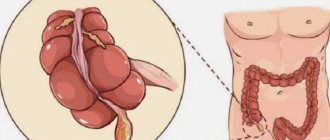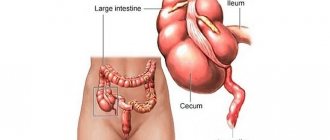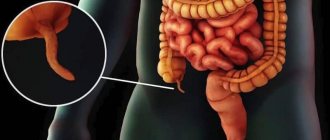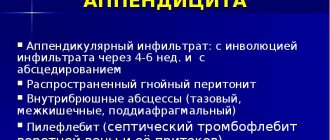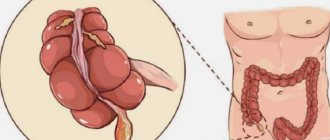Where is the human appendix located?
The appendix is part of the cecum, which is located in the right iliac fossa.
This area of the peritoneum includes:
- extreme ileum;
- cecum with vermiform appendix;
- beginning of the ascending colon.
The shape and size of the cecum with the appendix are variable due to the filling with gases and feces. In 80% of patients, the process lies in the right iliac fossa and is attached to a ligament of muscles, from which it is separated by a thin layer of fatty (retroperitoneal) tissue. In the remaining 20%, the appendix is attached directly to the tissue.
1 - high position, 2 - low position
During the autopsy, the surgeon takes into account the instability of the position of the process. Sometimes the organ is closed by the cecum or ascending colon, which provokes the development of adhesions. In this case, access to appendicitis is difficult: the appendix grows surrounded by fused muscles or grows to the posterior wall of the peritoneum.
Having seen the position of the appendix, the surgeon determines in which direction the inflammatory process has developed: towards the peritoneum or the fatty tissue of the retroperitoneal space (it is dangerous due to the development of a perirenal abscess).
To find the appendage, the doctor also takes into account the position of the bottom of the cecum, to which the appendage is attached. According to statistics, in women and men after 40, the appendix drops below the interosseous line and deepens 1–2 cm into the small pelvis.
Less common are abnormal positions of the cecal fundus:
- On the left side of the abdomen.
- In the navel area.
- In the hernial sac.
More about the anatomy of the appendix:
Which side is appendicitis located on?
To begin with, it is worth clarifying that the wording itself is not correct. Appendicitis is a disease.
The appendix is a small extension of the cecum.
For most people, the site of inflammation is the lower right side of the abdomen, just below the level of the navel. This arrangement is considered the standard and most common.
However, the appendix can be located in other places - this does not depend at all on gender or age. Such cases occur quite rarely, but still the non-standard location of the process of the cecum is the norm.
| Where is appendicitis located? | Characteristics - where does appendicitis hurt? |
| Sometimes the location of inflammation of appendicitis is in the pelvic area | This feature is most often found in women. Typically, appendicitis in the pelvic location is difficult to diagnose because the symptoms differ significantly from the standard location of the appendix. In this case, the person is worried about:
|
| In medical practice, cases have been recorded when the apex of the appendix was located not downwards, but upwards. | This location is usually called subhepatic. Pain on the right side, in the upper abdomen. Sometimes - under the ribs, directly under the liver. |
| The appendage of the cecum is located in the stomach area | In this case, it is difficult to answer the question on which side the stomach will hurt. The inflammatory process, as a rule, begins with ordinary stomach pain, which is characteristic of gastritis. |
| Often the process of the cecum is located outside the abdominal cavity. | Some patients claim that during inflammation of appendicitis, acute pain was observed in the lumbar region. |
| Less commonly, the location of the appendage is the area behind the cecum or along it. | The pain on the right side is dull and dull in nature. |
Photo: Where does appendicitis hurt?
To date, no specific cause for the development of appendicitis has been identified. Possible causes include the presence of pathogenic bacteria and blockage of the lumen of the cecum at the same time.
What appendicitis looks like: photo
The appendix is an organ with a complex structure and a number of features:
- Abundantly supplied with blood.
- Contains a large number of nerve endings.
- It communicates through nerve endings with other organs of the gastrointestinal tract.
The shape of the vermiform appendix is stalk-shaped. The embryonic and cone-shaped form is less common. The appendix is mobile. Atrophy of mobility indicates cured inflammation.
Photo of removed appendix
Usually the length of the vermiform appendix is 10 cm. Short, less than 1 cm, and long, more than 20 cm, appendices are observed less frequently. The average thickness is 1 cm. The dimensions depend on the age of the person. The longest appendices are observed before the age of 30. With aging, the length of the process decreases.
Functions of the appendix
Functions performed by the vermiform appendix:
- Secretory. The appendage secretes a secretion that affects intestinal motility and prevents coprostasis. 3–5 ml of biologically active substance is released per day.
- Contractile. The appendix contracts periodically, regardless of the rhythm of contractions of other parts of the intestine.
- Lymphocytic. Peak function is observed in adolescence. Every minute, a huge number of lymphocytes are released from the surface of the mucous membrane, which enter the venous blood. With old age, the walls of the appendix undergo sclerosis and the lymphatic tissue is destroyed. Until a person dies, the appendix remains a reserve of the immune system in an inactive state.
- Endocrine function. Performed during intrauterine development. From the moment of birth, endocrine function is taken over by the endocrine glands of the body.
- Production of immune system antibodies. The appendix is one of the links in the production of antibodies in the body's immune response.
- Participation in digestion. The shoot is involved in the digestion of fiber and starch.
- Maintaining the microbial background in the intestines. The appendix stores a supply of microorganisms that prevent food from rotting in the intestines.
Inflammation of the appendix
Appendicitis occurs in men and women aged 10 to 30 years. On average, this happens to 5 out of 1000 people per year.
Acute appendicitis
The causes of the disease have not yet been studied. There is an unconfirmed version that acute appendicitis is a precursor to colon and rectal cancer. This is evidenced by limited data from epidemiologists: people who did not suffer from inflammation of appendicitis were less likely to have cancer, polyps and diverticulosis of the colon.
Four main causes of inflammation:
| Cause: | Process description: |
| Mechanical | There is a blockage of the lumen between the intestine and the appendix. The following substances enter the lumen: feces, a foreign body (parasite) or a tumor. After a blockage, excess mucus accumulates in the appendix. This promotes the development of bacteria and inflammation of the mucous membrane |
| Infectious | It is believed that typhoid fever or parasitic infections can provoke inflammation of the appendix. But specific microflora for appendicitis has not yet been identified |
| Allergic | Under certain conditions, protein foods cause a delayed allergic reaction in the gastrointestinal tract. This type of reaction is characterized by a violation of the protective function of the mucous membrane of the appendix and the development of microflora, which provokes purulent inflammation |
| Angioneurotic | The muscles of the appendix spasm due to dysfunction of the neuroregulatory system, which controls the contraction of the walls of the appendix. Due to spasm, the mucous walls of the appendix swell, vascular thrombosis occurs and inflammation develops |
The period for removing inflamed appendicitis is 2 days. Prolongation of the period provokes the development of complications: diffuse peritonitis, abscess, intestinal fistula, etc.
Chronic appendicitis
A rare disease that develops after acute appendicitis. It is characterized by destructive changes in the walls of the appendix.
Patients complain of the same symptoms as with primary inflammation:
- nausea;
- weakness;
- temperature increase;
- pain and heaviness in the abdomen.
A number of authors believe that chronic appendicitis can develop without primary inflammation due to a congenital anomaly of the appendix.
What contributes to the development of appendicitis
An active part in the development of the disease is taken by a special “Focus” virus, discovered by US researchers, which acts on the principle of influenza viruses that cause inflammatory outbreaks of the appendix in the spring and summer, as well as representatives of the polymicrobial flora - coccal associations, rod-shaped intestinal and anaerobic flora.
It penetrates the walls of the appendix in an enterogenous way - through its lumen. Create conditions for inflammatory reactions:
- bending of the appendix, which provokes stagnation of intestinal contents in the appendix;
- blockage of the lumen with appendicular stones and other foreign bodies;
- excessive new formation of lymph tissue (hyperplasia).
The processes of mechanical blockade of the lumen of the appendage cause an increase in pressure inside the lumen and disrupt blood circulation in its walls.
Such “anomalies” reduce local immunity, activate pyogenic microflora and promote their penetration into the mucous lining of the organ.
Predisposing factors that cause the development of inflammation in the cavity of the appendix include the nature of the nutritional diet and the peculiarities of the localization of the appendix.
It has been proven that with a rich meat diet and a tendency to difficult bowel movements, excess protein breakdown accumulates in the intestines, which creates favorable conditions for the replication (reproduction) of pathogenic microorganisms.
In addition to mechanical causes, parasitic and infectious diseases such as typhoid fever, amebiasis, yersiniosis, intestinal tuberculosis and other infections can become a prerequisite for the development of inflammatory reactions in the appendix.
Women are at higher risk of developing the disease during pregnancy, which is due to changes in the immune system, the presence of constipation, and migration of the appendix along with the cecum caused by an increase in the size of the uterus and changes in blood supply to the pelvic organs.
Diagnosis of appendicitis
The diagnosis of “acute appendicitis” is clinical, made by a surgeon before performing an operation to remove the appendix. The clinical picture of acute appendicitis is not always clear due to non-unique symptoms.
Palpation during the initial examination of a patient with a complaint of appendicitis
To avoid mistakes, doctors resort to laboratory and instrumental diagnostics, which include:
- General blood analysis.
- General urine analysis.
- CT scan.
- X-ray of the abdominal cavity.
- Ultrasound.
- Diagnostic laparoscopy.
Surgery is used when non-invasive methods have failed. During diagnostic laparoscopy, the surgeon determines the stage of appendicitis (catarrhal, phlegmonous, gangrenous) and, if conditions permit, proceeds to remove the inflamed appendix.
Possible complications and their symptoms
Let's consider the complications after appendicitis that occur most often:
| Complication | How does appendicitis hurt during complications? |
| Seam divergence | It is possible for both internal and external seams to diverge. When the internal seams diverge, nausea, vomiting, and deterioration in health are observed. When the external sutures also separate, the wound opens. In some cases, bleeding may occur. |
| Peritonitis | It develops mainly in adults due to late presentation to a medical facility. The complication is manifested by abdominal pain, bloating and high fever. |
| Postoperative hernia | As a rule, it occurs due to divergence of seams. The appearance of a hernia can be caused by trauma in the peritoneum after surgery. |
How long does sick leave last after appendicitis?
A sick leave certificate is issued after surgery for 1–2 weeks. It will take so long for the body to recover. In case of complications, the sick leave is extended for the period necessary for complete recovery. After leaving the hospital, doctors recommend adhering to a gentle regimen.
Fast food banned after surgery
This applies to restrictions in:
- Food.
- Intimate life.
- Playing sports.
- Lifting weights.
- Drinking alcohol.
